- Bernard Preston homepage
- What's potting?
- Vegetable Garden Trellis
Vegetable garden trellis
A vegetable garden trellis can literally be built in a couple of hours; all you need is access to bamboo and a pair of heavy-duty shears.
I have built four of these in the last week; the first two, like the one above, are about 20 feet in length. The others are more than 15 metres. Practice makes perfect; the last couple of giants still took less than a couple hours.
Crop rotation is a vital part of backyard-permaculture. Planting legumes in the same place each year soon proved counter to the wisdom of the ages; pests began to proliferate.
Follow your summer beans with tall kale-plants that also need support, for example, but not with green peas which are also legumes.
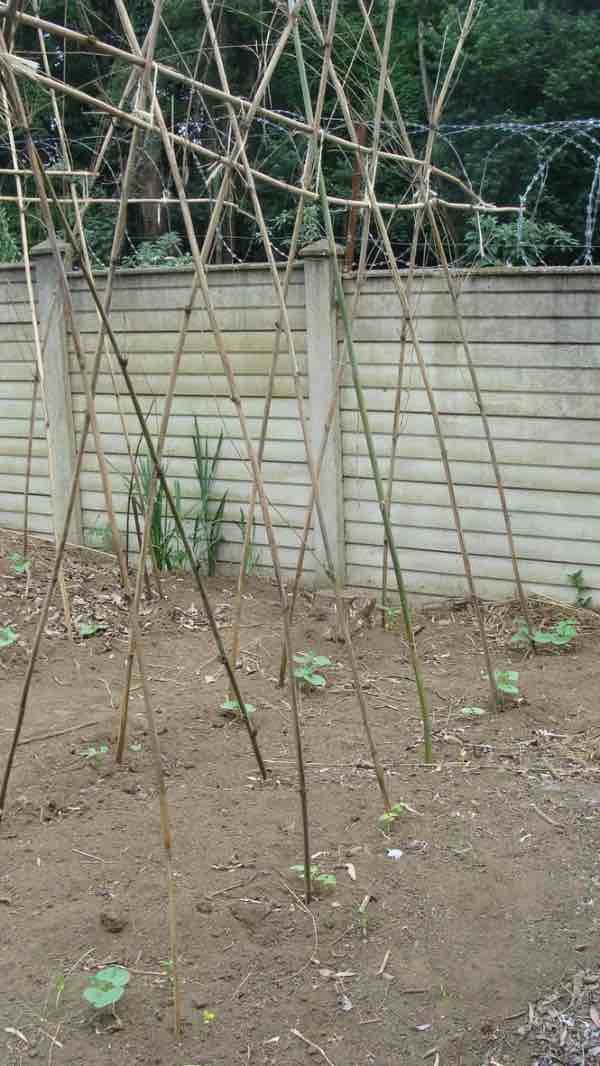
This page was last updated by Bernard Preston on 3rd March, 2025.
We put in a vegetable garden fence many years ago, actually half a dozen of them, with a plan to have support for climbing plants like pole beans, limas and green peas; tomatoes, a granadilla vine or even butternut too.
It was great for a few years but then it became apparent that, no matter how much humus we used, disease was increasing and the yield decreasing.
So now we grow a host of different vegetables on those fixed, steel garden-fences; and the pole beans only every third or fourth year.
Legumes provide wonderful nitrogen fixation for the next crop, but beans followed by peas, and then limas, proved to be less than successful; enter a mobile vegetable garden trellis.
Countering invasive aliens can be very frustrating, but eventually we accepted that short of bringing in agent orange, we might as well accept that they were here to stay, and make use of them where possible. Bamboo can be very useful in the garden for building a shield against hot sun, or our bees, and for growing a crop that needs staking and support.
The beauty of using bamboo is that whilst cutting back the invasive canes you can simultaneously put them to good use. And that can apply in one way or another to many of the unwanted aliens in your garden with a little imaginative thinking.
Vegetable garden trellis
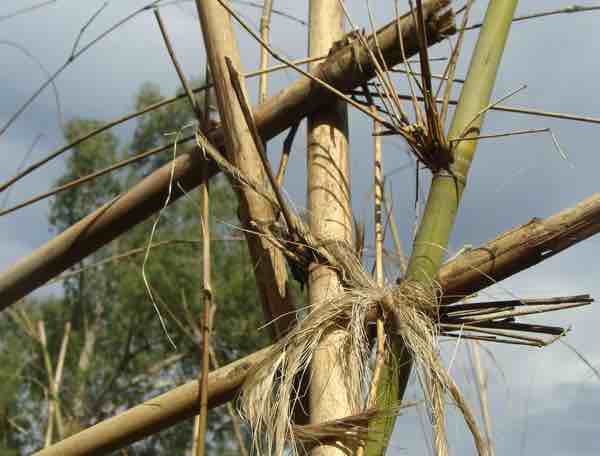
Your vegetable garden trellis need not cost a cent if you have access to some bamboo. It is perfect for crop rotation of climbing beans for example.
You will need a pair of strong shears. I cut the stakes to about 10 feet as they need to be sunk into the ground, and beans can grow quite tall given the space.
Make your trellis as long as you like. That shown in the graphic above is about 20 feet long, but I have another twice that length. When it is covered with leaves and fruit, it is prone to get blown over, so you can see two short lengths used to anchor the ends and in the graphic above I have also tied it to the boundary fence.
So, cut about 12 lengths for example for the teepee, two shorter pieces for the stabilization, and two longer lengths, one to sit above in the V, and another below.
"They who do not live by the truth they acknowledge, thereby become the greatest enemies of truth itself."
- Julius Rupp, 19th Century Lutheran pastor
Press the stakes as deeply into the ground as possible; at least 18". If the earth is compacted you will have to loosen it with a pick so that you can sink your bamboo adequately. Mark I that I built some five years ago was in fact blown over in a strong wind. Let them cross about five feet above ground, forming a teepee.
Now force the two short lengths into the ground so they lie along the line of the structure, preventing movement. Using some strong, but biodegradable twine, tie the ends securely.
We now reluctantly use plasticized twine, justifying it because it we recycle simply everything in our home; it is utilized again on the next vegetable garden trellis.
Now cut two long lengths, placing one above the V, the other below, and bind them strongly with the twine.
Plant your seeds.
Newsletter
Our newsletter is entitled "create a cyan zone" at your home, preserving both yourself and Mother Earth for future generations; and the family too, of course. We promise not to spam you with daily emails promoting various products. You may get an occasional nudge to buy one of my books.
Here are the back issues.
- Lifestyle and ideal body weight
- What are ultra-processed foods?
- Investing in long-term health
- Diseases from plastic exposure
- Intensive lifestyle management for obesity has limited value
- A world largely devoid of Parkinson's Disease
- The impact of friendly bacteria in the tum on the prevention of cancer
- There's a hole in the bucket
- Everyone is talking about weight loss drugs
- Pull the sweet tooth
- If you suffer from heartburn plant a susu
- Refined maize meal and stunting
- Should agriculture and industry get priority for water and electricity?
- Nature is calling
- Mill your own flour
- Bake your own sourdough bread
- Microplastics from our water
- Alternative types of water storage
- Wear your clothes out
- Comfort foods
- Create a bee-friendly environment
- Go to bed slightly hungry
- Keep bees
- Blue zone folk are religious
- Reduce plastic waste
- Family is important
- What can go in compost?
- Grow broad beans for longevity
- Harvest and store sunshine
- Blue zone exercise
- Harvest and store your rainwater
- Create a cyan zone at your home
Really, cutting the bamboo, trimming the stakes to length, forcing them into the ground and tying the whole vegetable garden trellis took me less than two hours.
The beauty of pole beans is that they go on bearing for several months, and will keep you in vegetable protein every day. Obviously a shovelful of compost, perhaps mixed with well rotted chicken manure around each stake will improve your crop no end.
Once the beans are well established, we'll use worm wee to supplement the feed for our plants; for young, sensitive seedlings it must be well diluted.
If you have never considered the wonder of worm farms, then it is time to go the next step into organic gardening. They will clean up all your kitchen waste, and a whole lot more and turn it in weeks into beautiful compost for your veggies.
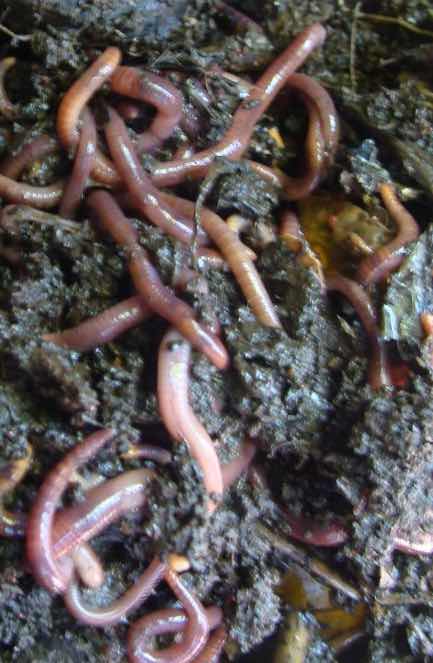
I will be adding photos as the beans grow; come back every few weeks to watch the progress of our plants.
You could use this just as easily for tomatoes, vines such as gem squash or a host of other tall vegetables.
I would leave this garden trellis in place for two or perhaps three years, and then discard it and start anew in a another location.
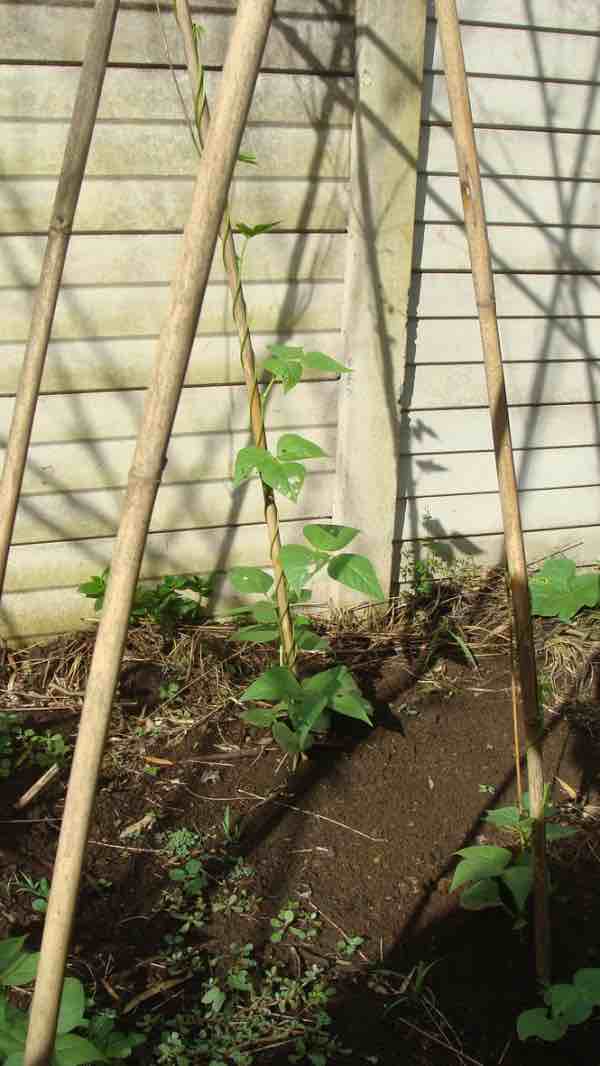
The first beans are already over a metre tall in just a couple weeks. Soon Jack will have something to climb.
Where is our water coming from is a cry that will soon be echoing in every nook and cranny of the planet. We harvest our from the rain and store it in an underground reservoir and suburban tanks.
Water scarcity in the world is a problem that is not going away, and we must each play our part; use much less or start collecting that which falls into your lap, read on your roof. We even drink it without reservation since discovering the horrors of post-chlorination.
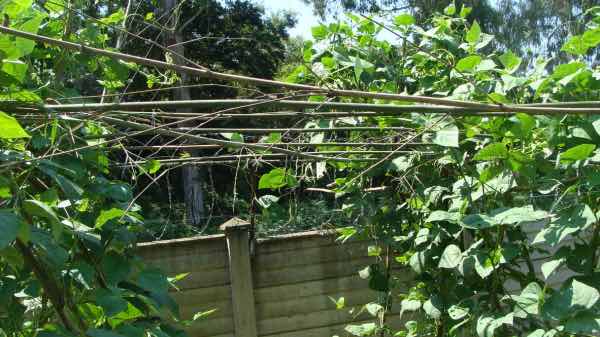
It is now two months and we are enjoying a handful of beans every night; the plants have nowhere to go, so I've placed some cross bracing between the two trellis' for support and more room for them to expand. That will also provide more cover to shade out the weeds that are proliferating in the compost and worm wee.
There is nothing to cooking green beans.
A garden like this will produce three of the four vitamins necessary to prevent the onset and rapid progression of frailty syndrome. Do you know what they are and which one is missing? Researchers found they were far more effective from your food than in supplements[1].
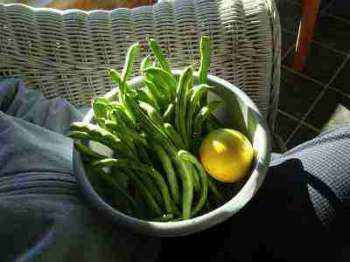
- Backyard permaculture.
- Growing green beans - copy and paste into the site search function on your left for more information.
When browsing use right click and "Open Link in New Tab" or you may get a bad gateway signal.
I am a retired DC; the closer you get to eighty, the more passionate you get about enjoying a long and full-life. One small but important discipline for the gardener is two or three minutes of lower back exercises done every morning before getting out of bed.
Otherwise you will be consulting someone before long. Take my word for it; prevention always did make more sense than a cure and nowhere is it more true than in the garden.
Even so I still also need an adjustment every month or two; with the best will in the world, with heavy turning of the compost pile, or sleeping upright in a plane, most of us need regular spinal care. Aim for at least half a dozen treatments every year, but more if you have had serious injuries to your neck or back obviously.
I once needed 18 treatments in a month when I injured my lower back lifting a heavy patient but that was the exception that proves the rule. Follow this slipped disc diary for more about that.
But if it seems like you will need to mortgage your house to pay for all the treatment recommended, then move on to another DC; greed I confess has invaded our profession too.
Copy and paste "slipped disc diary" into this search engine for more information.
"If you have a garden and a library, you have everything you will ever need."
- Marcus Cicero, Roman politician, lawyer and orator
If you read just one-book a month you will probably fall short of a thousand in your whole life; and most likely nearer 500. Enjoying a good yarn is like having a private conversation with the author.
If you are benefiting from these pages then perhaps I can invite you to a journey through the polders of Holland. That is how you can support this site and enrich your own life with some easy bedside reading; step up to greater well-being.
My books are available from Amazon on Kindle.
Did you find this page interesting? How about forwarding it to a friendly book or food junkie? Better still, a social media tick would help.
- Bernard Preston homepage
- What's potting?
- Vegetable Garden Trellis
Address:
56 Groenekloof Rd,
Hilton, KZN
South Africa
Website:
https://www.bernard-preston.com